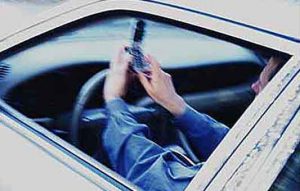
Texting
Using hands-free devices to talk, text or send e-mail while driving is distracting and risky, contrary to what many people believe, says a University of Utah study issued by the AAA Foundation for Traffic Safety.
In a 2006 study, University of Utah psychology Professor David Strayer, lead author of the study, first showed talking on a hands-free cell phone was just as distracting as using a hand-held phone while driving, but the message has failed to fully connect with the public, with many people believing hands-free devices are safer.
“Our (new) research shows that hands-free is not risk-free,” says Professor Strayer.
The research found that as mental workload and distractions increase, reaction time slows, brain function is compromised, drivers scan the road less and miss visual cues, potentially resulting in drivers not seeing items right in front of them including stop signs and pedestrians.
This is the most comprehensive study of its kind to look at the mental distraction of drivers and arms AAA with evidence to appeal to the public to not use these voice-to-text features while their vehicle is in motion.
With a predicted five-fold increase in infotainment systems in new vehicles by 2018, AAA is calling for action as result of this landmark research.
“There is a looming public safety crisis ahead with the future proliferation of these in-vehicle technologies,” said AAA President and CEO Robert L. Darbelnet.
“It’s time to consider limiting new and potentially dangerous mental distractions built into cars, particularly with the common public misperception that hands-free means risk-free.”

Cognitive distraction expert David Strayer and his research team at the University of Utah measured brainwaves, eye movement and other metrics to assess what happens to drivers’ mental workload when they attempt to do multiple things at once, building upon decades of research in the aerospace and automotive industries. The research included:
— Cameras mounted inside an instrumented car to track eye and head movement of drivers.
— A Detection-Response-Task device known as the “DRT” was used to record driver reaction time in response to triggers of red and green lights added to their field of vision.
— A special electroencephalographic (EEG)-configured skull cap was used to chart participants’ brain activity so that researchers could determine mental workload.
Using established research protocols borrowed from aviation psychology and a variety of performance metrics, drivers engaged in common tasks, from listening to an audio book or talking on the phone to listening and responding to voice-activated emails while behind the wheel.
Researchers used the results to rate the levels of mental distraction drivers experienced while performing each of the tasks.
Similar to the Saffir-Simpson scale used for hurricanes, the levels of mental distraction are represented on a scale:
— Tasks such as listening to the radio ranked as a category “1” level of distraction or a minimal risk.
— Talking on a cell-phone, both handheld and hands-free, resulted in a “2” or a moderate risk.
— Listening and responding to in-vehicle, voice-activated email features increased mental workload and distraction levels of the drivers to a “3” rating or one of extensive risk.
“These findings reinforce previous research that hands-free is not risk-free,” said AAA Foundation President and CEO Peter Kissinger.
“Increased mental workload and cognitive distractions can lead to a type of tunnel vision or inattention blindness where motorists don’t see potential hazards right in front of them.”
Based on this research, AAA urges the automotive and electronics industries to join us in exploring:
— Limiting use of voice-activated technology to core driving-related activities such as climate control, windshield wipers and cruise control, and to ensure these applications do not lead to increased safety risk due to mental distraction while the car is moving.
— Disabling certain functionalities of voice-to-text technologies such as using social media or interacting with e-mail and text messages so that they are inoperable while the vehicle is in motion.
— Educating vehicle owners and mobile device users about the responsible use and safety risks for in-vehicle technologies.
“Just because you can update Facebook while driving doesn’t mean that it is safe to do so,” Strayer adds.
“Don’t assume that if your eyes are on the road and your hands are on the wheel that you are unimpaired.
If you don’t pay attention then you are a potential hazard on the roadway.”
Strayer conducted the study with these other members of the University of Utah Department of Psychology: Joel M. Cooper, research assistant professor of psychology; and doctoral students Jonna Turrill, James Coleman and Nate Medeiros-Ward and Francesco Biondi.
For more information
AAA Foundation for Traffic Safety
Link…
The University of Utah
Link…
MDN
This post is also available in:
 Italian
Italian


